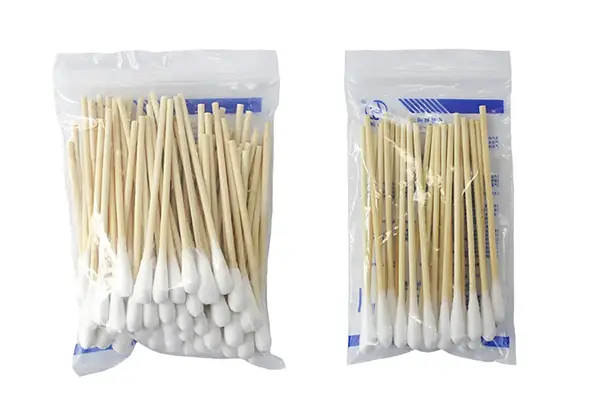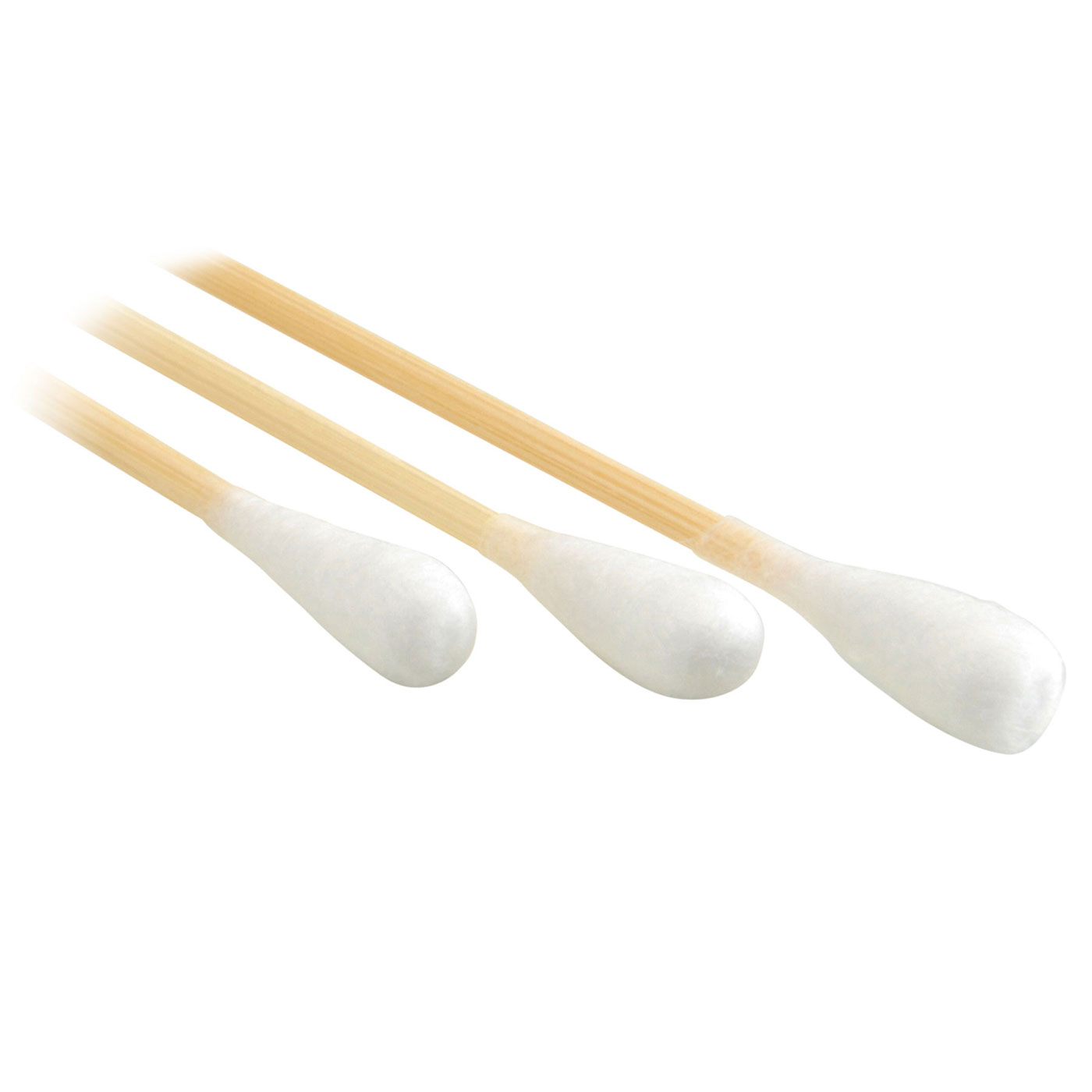As a procurement manager or medical supply distributor, you know that the smallest details matter most. A simple item like a sterile cotton swab can have a significant impact on patient care, laboratory results, and procedural outcomes. This guide is designed to cut through the noise and provide clear, actionable insights into selecting the best sterile cotton-tipped applicators. We will explore everything from the importance of the wood shaft to why an individually wrapped pack is non-negotiable for medical use. My name is Allen, and with years of hands-on experience managing 7 production lines in our medical consumables factory, I want to share what truly defines a high-quality sterile swab and how you can confidently source them for your organization. This article will help you make informed decisions, ensuring you procure a product that meets the highest standards of safety and performance.
What is the Difference Between a Regular and a Sterile Cotton Swab?
It’s a common question, and the answer is critical for anyone in the healthcare supply chain. While a standard cotton swab (often called a cotton bud) is perfect for everyday tasks like makeup application or household cleaning, it is not suitable for medical procedures. The key difference lies in one word: sterile.
A regular cotton swab is manufactured in a clean environment but is not free from microorganisms. A sterile cotton swab, on the other hand, undergoes a rigorous sterilization process to eliminate all viable microbes, including bacteria, viruses, and fungi. This process, typically using Ethylene Oxide (EtO) gas or gamma irradiation, is validated according to international standards like ISO 11135. Each sterile swab is then sealed in its own pouch to maintain this state of sterility until the moment it’s used. Using a non-sterile swab for wound care, sample collection, or applying medication can introduce harmful pathogens, leading to infections and compromising patient safety. For any medical or clinical application, only a certified sterile product will do.

Why are Puritan and Medline Sterile Swabs Considered Industry Benchmarks?
In any industry, certain brand names become synonymous with quality, and in the world of medical swabs, Puritan and Medline sterile products have certainly earned that reputation. For a procurement manager like Mark Thompson, seeing these names often provides a sense of assurance. This reputation is built on decades of consistent manufacturing, adherence to strict regulatory standards (like FDA and CE), and the use of high-quality raw materials. Their cotton-tipped applicators are known for having tightly wound tips that don’t shed fibers and sturdy shafts that won’t easily break.
However, as a factory manager here in China exporting to the USA and Europe, I can tell you that benchmark quality is not exclusive to these brands. Many specialized manufacturers, including our own, adhere to the very same principles. The secret lies in the process. We use high-purity, medical-grade cotton and choice birch for our wood applicator shafts. Our production lines are automated to ensure consistency, and every single batch of sterile swabs undergoes a strict quality control protocol before being released. The goal is to produce a swab that performs just as reliably as a Puritan or McKesson cotton-tipped applicator, providing a dependable and cost-effective alternative for hospitals and clinics worldwide. When sourcing, the key is to look beyond the brand and at the certifications, batch traceability, and quality of the product itself.
How Do I Choose Between a Wood Shaft and a Plastic Shaft Applicator?
The shaft of the applicator is more than just a handle; it’s an integral part of the tool’s function. The choice between a wood shaft and a plastic shaft depends entirely on the intended application.
Here is a quick comparison table:
| Feature | Wood Shaft Applicator | Plastic Shaft Applicator |
|---|---|---|
| Material | Typically birch wood or bamboo | Polypropylene or Polystyrene |
| Rigidity | Sturdy and firm, less flexible | More flexible, can bend to reach tight areas |
| Best For | General wound care, applying ointments, specimen collection from open areas, tattoo preparation. | Oropharyngeal or nasopharyngeal sample collection, ear cleaning, use in delicate electronics. |
| Breakability | Can snap under high pressure, may splinter (though rare with high-quality wood). | Less likely to snap; tends to bend first. |
| Eco-Friendliness | Biodegradable, especially bamboo cotton swabs. | Not biodegradable. |
From my experience on the factory floor, we see hospitals ordering large quantities of cotton swabs with wooden handles for their general wound dressing kits and daily care routines. The firm wood shaft provides excellent control for cleaning a wound or applying a topical medication. Conversely, specialized clinics and labs often prefer the flexibility of a plastic shaft for tasks requiring navigation around sensitive contours. A JMU sterile cotton tipped applicator with a plastic shaft, for example, is ideal for diagnostic testing. The choice isn’t about which is better overall, but which tool is right for the specific job.
Why is an "Individually Wrapped" Pack Crucial for a Sterile Cotton Tip Product?
This is a point I cannot emphasize enough. The term "sterile" is only valid as long as the product is protected from the environment. An individually wrapped design is the only way to guarantee that a sterile cotton swab remains sterile from our factory to the patient’s bedside.
Imagine a box of 100 loose sterile swabs. The moment the box is opened, all 100 swabs are exposed to airborne contaminants. The entire lot is compromised. This is why you will see every reputable medical swab packaged individually, often with one swab per peel-apart pouch (1 per pouch). This design ensures that a healthcare professional can open one swab for a single-use application without compromising the rest of the box. It’s a fundamental principle of aseptic technique.
When you, as a procurement officer, are evaluating a potential supplier, insist on seeing a sample of the packaging. The wrap should be durable, easy to open without contaminating the swabstick, and clearly marked with lot numbers and expiration dates. A supplier that offers a multi-pack or a loose pack for a sterile cotton product does not understand the fundamentals of medical hygiene and should be avoided. We offer a variety of packaging options, from a single box of 100 packs to bulk cases of 10 boxes, but every single sterile swab is always individually sealed.

What are the Main Uses for a 6 Inch Long Sterile Swab in Wound Care?
The 6 inch long sterile cotton swab is one of the most versatile tools in a healthcare setting, particularly for wound care. Its length provides a safe distance between the clinician’s hand and the wound site, minimizing the risk of contamination while offering excellent reach and control.
Here are some of its primary uses in wound care:
- Cleaning and Debridement: The cotton tip is used to gently clean debris and exudate from a wound. It can be moistened with saline or an antiseptic solution to aid in the removal of non-viable tissue.
- Applying Medication: The absorbent cotton tip is perfect for applying ointments, creams, and other topical medications directly and precisely onto the wound bed. This is far more accurate than using a finger or a larger dressing.
- Wound Measurement: The shaft of the applicator can be used to gently probe the depth of a puncture wound or tunnel, which is crucial information for documentation and treatment planning.
- Specimen Collection: For wounds that may be infected, a 6 inches sterile swab is the standard tool for collecting a culture sample. The swab is gently rolled over the wound surface to collect a representative sample for laboratory analysis.
The simple design of these applicators 6 inch long makes them indispensable. They are a core component of almost every first aid kit, surgical prep tray, and dressing change cart in hospitals and clinics around the world. We manufacture millions of these swabs, ensuring the wood shaft is smooth and the pointed cotton tip is securely bonded for reliable performance in critical situations.
How Can I Verify the Quality of a Box of 100 Sterile Cotton Swabs?
For a procurement manager, ensuring product quality is paramount. When a shipment of a box of 100 sterile cotton swabs arrives, you can’t just rely on the label. There are several physical checks and documentation reviews you should perform.
Physical Inspection Checklist:
- Packaging Integrity: Check the outer box for any damage. Then, inspect the individual pouches. Are the seals intact? There should be no rips, punctures, or signs of moisture. A compromised package means a non-sterile product.
- Swab Construction: Open a sample pouch. Examine the cotton tip. Is it bright white and tightly wound? Gently tug on it. A high-quality swab will not shed fibers or have the tip come loose from the wood shaft.
- Shaft Quality: Roll the wood applicator between your fingers. It should be smooth and free of splinters. If it’s a plastic shaft, it should be free of sharp edges from the molding process.
- Labeling: The packaging must be clearly labeled. Look for the manufacturer’s name, the word "sterile," a lot number for traceability, and an expiration date. These are non-negotiable regulatory requirements.
Documentation Review:
- Certificate of Conformance (CoC): Always request a CoC from your supplier for each batch. This document certifies that the product meets all required specifications.
- Sterilization Certificate: Ask for proof of sterilization for the specific lot number you received. This provides evidence that the sterile cotton swab batch successfully completed a validated sterilization cycle.
- ISO/CE Certifications: Ensure your supplier has valid ISO 13485 (Medical Devices Quality Management Systems) and, if applicable for your region, CE marking or FDA registration.
As a manufacturer, we welcome these checks. We provide all this documentation with every shipment because we are proud of our quality control. A transparent and forthcoming supplier is a sign of a reliable partner.

Beyond the Clinic: Are There Other Uses for Medical Swabs?
While their primary design is for medical use, the same features that make sterile swabs great for healthcare—precision, cleanliness, and disposability—make them incredibly useful for a wide range of other tasks. The versatility of these simple tools is often underestimated.
- Electronics and Tech: The lint-free cotton tip is perfect for cleaning sensitive electronic components, such as camera sensors, circuit boards, and computer ports. Their non-abrasive nature prevents scratches.
- Cosmetic and Beauty: In the beauty world, a pointed cotton tip cotton swabs is a professional’s best friend for precise makeup application, correcting eyeliner mistakes, or for removal of nail polish from the cuticle area. They are also used extensively in tattoo artistry for cleaning skin and applying ointments.
- Hobbies and Crafts: From building intricate models to cleaning delicate antiques or jewelry, the swabstick provides a level of detail and control that larger tools can’t match.
- Pet Care: A sterile swab is an excellent tool for applying medication to a pet’s skin or for gentle ear cleaning, ensuring you don’t introduce bacteria into a sensitive area.
Even for these non-medical uses, starting with a high-quality medical swab ensures you are using a clean, well-made product. A box of 100 total swabs can be a valuable addition to any workshop, art studio, or household cleaning kit.
What Should a Supply Manager Look for in a Cotton Tipped Applicator Supplier?
Finding the right supplier is about more than just finding the lowest price for a medical cotton swab 7.5CM disposable. It’s about building a partnership that ensures a reliable and safe supply chain for your organization. As someone on the manufacturing side, I talk to procurement managers like Mark every day. Here’s what separates a great supplier from an average one:
- Regulatory Compliance and Transparency: A trustworthy supplier will readily provide all necessary certifications (ISO 13485, CE, etc.) and will be transparent about their quality control processes. They should be able to provide full traceability for every product, from raw material to finished sterile swab.
- Communication: Inefficient communication is a major pain point. Your supplier contact should be knowledgeable, responsive, and fluent in your business language. They should understand your needs and be proactive in providing updates on your orders.
- Product Quality and Consistency: The supplier must demonstrate consistent quality across all batches. Request samples from different production runs. A good manufacturer has minimal variation between a swab made in January and one made in June. The quality of our absorbent dental cotton rolls is a testament to this consistency.
- Logistical Reliability: Shipment delays can cripple a hospital’s inventory. A good supplier has robust logistics, understands international shipping, and provides realistic delivery timelines. They should work with you to mitigate potential delays.
- Flexibility and Partnership: The best suppliers act as partners. They understand your business and can offer customized solutions, whether it’s specific packaging like a 500 count box, different shaft lengths, or a unique cotton tip size. They are invested in your success.
Attending medical trade shows and exhibitions is a fantastic way to meet suppliers face-to-face and gauge these qualities firsthand. It allows you to handle the product and have the in-depth conversations needed to build a lasting and reliable business relationship.
What Are the Best Practices for Storing and Handling a 500 Count Box?
Proper storage is the final, critical step in maintaining the integrity of your sterile medical supplies. You can source the best sterile cotton swab in the world, but if it’s stored improperly, its sterility can be compromised. When you receive a large 500 count case or multiple boxes of 200 sterile cotton swabs, follow these simple rules.
- Cool, Dry, and Dark: Store the boxes in a clean, dry area away from direct sunlight and extreme temperatures. Humidity is the enemy of sterile packaging, as it can weaken paper pouches and adhesive seals over time.
- First-In, First-Out (FIFO): Always organize your stock so that the oldest products are used first. Check the expiration dates on the boxes and arrange them accordingly. This prevents waste and ensures you are always using a product that is well within its shelf life.
- Off the Floor: Never store medical supply boxes directly on the floor. Use pallets or shelving to keep them elevated, protecting them from moisture, dirt, and pests.
- Handle with Care: Instruct your staff to handle the boxes carefully to avoid crushing them or puncturing the individual pouches inside. A dedicated storage box or bin can help protect the cartons.
These simple hygiene and inventory management practices are essential. They ensure that the last swab in the box is just as safe and sterile as the first one. Just as with our other wound care products like sterile absorbent gauze pads, proper storage is key to their effectiveness.
The Future of Applicators: Innovations in Swabstick and Cotton-Tipped Technology
The humble swabstick is not immune to innovation. The drive for better diagnostic accuracy, improved patient comfort, and environmental responsibility is pushing the industry forward. We are constantly researching and developing new products to meet these evolving needs.
One of the biggest trends is the move towards more eco-friendly materials. Bamboo cotton swabs are gaining popularity as a sustainable alternative to both plastic and traditional wood, as bamboo is a fast-growing and renewable resource.
In diagnostics, there are significant advancements in tip technology. Flocked swabs, which use a spray-on nylon fiber technology instead of a wound cotton tip, can elute (release) a much higher percentage of a collected sample (DNA, viral, or bacterial) for testing. This improves the sensitivity of diagnostic tests. We are also seeing the development of swabs with tips that are pre-treated with reagents to preserve a sample or even begin the testing process right on the swabstick.
As a manufacturer, it’s an exciting time. We are committed to being at the forefront of these innovations, ensuring that we can continue to provide our partners—hospitals, clinics, and distributors—with the most effective, reliable, and advanced single-use tools for modern healthcare.
Key Takeaways to Remember
- Sterile vs. Non-Sterile: For any medical application, from wound care to sample collection, a sterile cotton swab is the only safe choice to prevent infection.
- Individual Wrapping is Mandatory: The sterile integrity of a swab is only maintained if it is individually wrapped. Never use a sterile product from a previously opened multi-pack.
- Quality is Verifiable: Don’t just trust the label. Physically inspect the product and packaging, and always request key documentation like Certificates of Conformance and sterilization certificates from your supplier.
- Choose the Right Tool: The choice between a wood shaft and a plastic shaft depends on the specific task. Wood offers rigidity, while plastic provides flexibility.
- The Supplier is a Partner: Look for a supplier that values transparency, communication, and regulatory compliance as much as you do. A reliable partnership is the foundation of a safe and efficient medical supply chain.
Post time: Jun-17-2025





